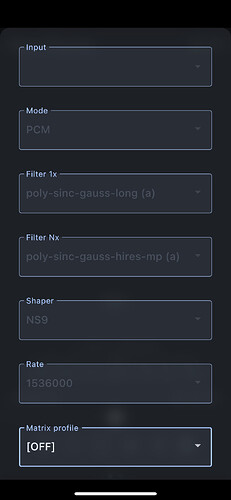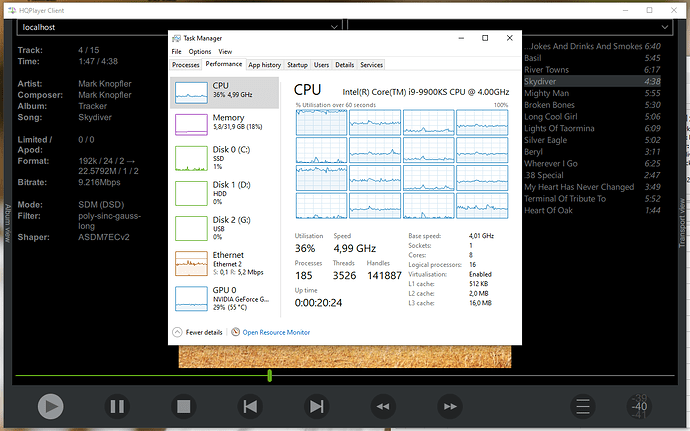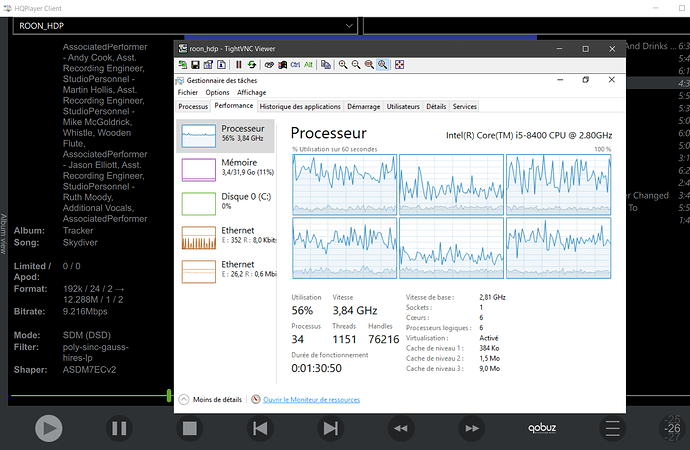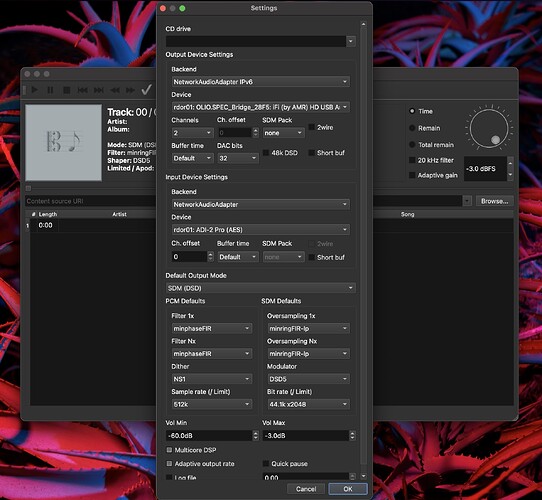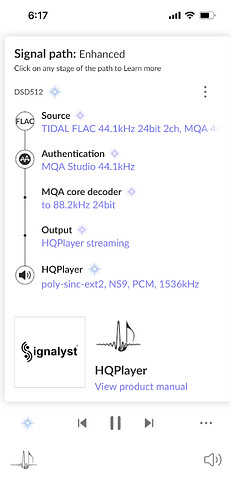48k to 44k.
What OS is used? I have the same limitations as you but with a now aging i5-8400 overclocked to 4Mhz (DSD256 7ECv2 up to 96k input and DSD512, but only in ASDM7 512+fs).
Does anyone have any issues with latest HQPDCONTROL v4? I’m only able to see the EQ settings but other features are grayed out.
That’s the way it should be if you are playing music. Stop playing, they become available.
Omg! So stupid of me! I was getting used to be able to change the Matrix while listening ![]() music and I totally forgot about it!!
music and I totally forgot about it!!
Matrix is one thing you “can” change while music is playing.
Windows 11, i9-9900KF (overclocked @ 4.9-5.0 GHz), Nividia GeForce RTX 3060.
I can upsample everything to 44.1kHz 512 DSD, including 192kHz PCM, but I need to use the same ASDM7 512+fs as you do.
For 192 PCM and ASDM7ECv2 modulaor, I need to go as low as DSD128 with longer filters.
(edit: after more tests, it looks like it’s a network issue rather than CPU issue. When I use the USB asio input instead of the A26’s LAN input, I don’t get any stuttering. For LAN input, I need to lower the buffer to 5-10 ms, otherwise it creates other clicks and interruptions… Maybe the lower buffer is what’s causing stuttering at higher Bit rates? I don’t know.)
Which begs the question : what to prioritize? 1) Bit rate first? 2) Oversampling filter second? 3) Modulator third? I’m sure many people experienced different combinations, I’ll do the same but I was curious to know if there is some sort of consensus on that question.
Jussi mentionned somewhere that (contrary to PCM upsampling?) “the DSD filter is just a noise filter to cut off ultrasonic noise from the modulator, it is not used to change the sampling rate”. So maybe, with limited CPU resources, it’s better to lower the bit rate and get an EC modulator which supposedly makes the sound a little more clear and focused?
For the time being, I have not decided to upgrade my server which runs well on Win10 (very, very optimized). It took me some time and I admit that setting up a new fanless server with a more powerful CPU is not the priority of the day!
On the other hand, I simply limited my Qobuz stream to 96k… and no more limitation (with 192).
But there is still one limitation to listen my DSD via Roon.
I did not find the settings (Roon + HQP) to play them in DSD256 ECv2. Had to change modulator or switch to something else.
@KML : On your server, a latencymon test gives what result?
What kind of network infrastructure do you have? This sounds like possibly 802.3x Flow Control is not becoming active on the path to the A26. The small embedded CPUs used for these kind of NAA typically cannot keep up with full 1 Gbps speed. 802.3x is implemented in ethernet controller hardware, and it will ask sender to stop when it sees that it’s hardware packet buffer gets full. If this feature doesn’t become active, packets are lost and need to be re-sent. This re-sending in turn doesn’t make the situation particularly better…
HQPlayer’s buffer time is calculated for the sampling rate. So 10 ms buffer at DSD512 will be twice bigger in size than at DSD256.
- Filter, 2) Modulator, 3) Bit rate.
But to a limit. So I would try to stick to DSD256 and certainly not go below DSD128.
I would say in many cases DSD256 with EC modulator is better than DSD512 without…
This is maximum I can do on my non-overclocked i9-9900KS + GTX 1080:
gauss-xla from 192k is too much for the GTX1080 to handle. It could be on the edge for RTX3060.
On GUstard R26/A26, there is a 100Mb card :
SigmaStar SSD201/SSD202 with 128mo of memory.
And I reinstalled my direct link (which is not supported by Jussy ![]() ) without going through a switch (direct IPV6 between HQPlayer server and streamer).
) without going through a switch (direct IPV6 between HQPlayer server and streamer).
Web --> Tenda --> Eth1/IPV4 --> Roon
192.168.1.59 (fixe)
|--> HQP --> Eth2/IPV4-IPV6 --> GusA26 IPV6 (dhcp)
192.168.1.60 (fixe) 192.168.1.61(dhcp)
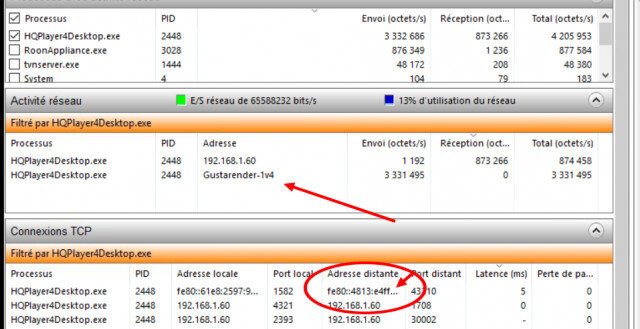
And if you turn off CUDA offloading? Same still works with your 9900KS ?
Although for PCM192k my 9900K is using the easier gauss-hires-lp
Yes it does, just checked.
Thanks for the explanation. That would explain why I can’t upsample 192 PCM to EXT3 / ASDM7ECv2 DSD256 44k (it stutters), while I can do it @ 48k (no stutter with my i9-9900KF @ 4.9kHz).
Thank you for sharing. So I did another test this morning, and I am unable to hear a difference. I might have hallucinated all this. ![]()
Anyways, thanks everyone! It’s nice to be able to share audition experiences with this amiable community. ![]()
It’s nice to see another person using ADI-2 (Pro) for HQPlayer input ![]()
Very cool
I’ve been playing more with the filters and, perhaps unsurprisingly, I keep coming back to poly-sinc-gauss-long. Gauss-xl(a) still has nicer timbre than the sinc filters, but it sounds a little more like them in terms of the music being “presented to me” instead of me being able to be a participant.
I’m wondering if it’s because of the length/sharpness of the filter. There’s something different about the gauss-long compared to pretty much all the other filters I’ve tried (and I’ve not tried them all yet). I think it might sacrifice some of the depth in favour of having the sounds more clearly separated. They also appear to be presented more left-to-right as opposed to in front of me and going away towards the horizon, so to speak. A more intimate presentation, which to me is great because I listen on headphones where with this filter I almost feel the physical presence of each sound; no idea how this would sound on speakers which perhaps could benefit from that ultimate depth (speakers being able to reproduce soundstage better).
In addition to better separation and timbre, music on gauss-long sounds like a coherent whole, with particular sounds smoothly and seamlessly interacting with each other. Using sinc filters, it feels more like individual pressure points, so to speak, being launched at me in a more aggressive way (can be impressive and even enjoyable, but only for short listens). Which gives extra “punch” but creates that impression that music is made up of Lego blocks (I think it was Jussi who used this analogy before, although that was in relation to PCM vs DSD - it’s way worse using PCM on my DAC, DSD helps a lot but it’s not until I switch over to the gauss-long filter that the phenomenon seems to be completely gone).
It would appear to me that the more intimate stage of the gauss-long filter would be mostly due to it being a shorter filter (“long” by name but short compared to xl(a) and sinc filters, I presume). Some say that shorter filters result in the soundstage “collapsing”. It would certainly appear to be that the sharpest filters create the best perception of depth, albeit it seems to happen at the cost of a lack of intimacy when needed, i.e. sounds are always placed slightly away from me (what I call the HD800 effect) which is perhaps one of the main reasons for the perception of depth. Whatever the “objective truth”, I prefer the gauss-long filter for headphone listening by a large margin. It’s just way more convincing. It’s like the soundstage wraps around my ears (gauss-long) as opposed to everything being presented centre-stage (sinc).
The gauss-xl(a) filter also appears to behave more like sinc filters soundstage-wise which would seem to confirm my hypothesis about this being directly correlated to the length/sharpness of the filter.
Another thing that’s occurred to me is that perhaps some of my observations are due to there being less pre/post-ringing with the gauss-long filter. Perhaps this has some effect on how tired/sensitive my ears get which would explain why I perceive this filter to be more natural-sounding.
If my observations are (at least partially) correct, then this would further support the claim of this filter being a really good trade-off both in terms of soundstage presentation as well as punchy vs natural sound (eliminating pre/post-ringing without significantly flattening/smoothing over the signal).
Gauss-xl(a) impressed me initially but once again it’s only gauss-long that is standing the test of time.
Ah, one more thing - there seems to be something wrong with the gauss-hires-lp, at least with 88.2K content (specifically, Daft Punk - Random Access Memories). It sounds rather muddy and less clear than gauss-long. I assumed it would be the same as gauss-long except somehow tweaked for high-res content, but at least on this album this is not the case. Perhaps this filter should only be used with even higher-res content than 88.2?
In my experience, the poly-sinc-gauss-hires-lp filter works great with all PCM content above 1x.
Yes, that is the case, xl(a) is 8 times longer than long.
It is similar, but not as steep, as the higher rates have more frequency space for a bit more relaxed filter slope. At 88.2k it is only 1/4th in time compared to long at 44.1k. For example it is a good match for Steven Wilson’s hires productions.
Get Lucky is one of my frequent test tracks. It has content up to about 42 kHz. Random Access Memories is certainly one of the albums that may benefit from longer/steeper filters. long or xl(a) should work well for it.
Hey all
So, its only going to be me, my laptop and my HyperX Cloud 2 headset with its dongle for about 3 months till im back home!
The dongle only supports 16 bit / 48,000.
Whats the best hqplayer settings for me? Is it even worth running filters?
Thanks!
